
MAY CONTAIN NUTS

Search Shorpy
SHORPY ART

Framed or unframed, desk size to sofa size, printed by us in Arizona and Alabama since 2007. Explore now.
Join and Share
Ad-Free Shorpy
Shorpy is funded by you. Patreon contributors get an ad-free experience.
Learn more.

Recent comments
- If You’re Like Me, Never
- U.S.A.
- S&P
- 1940 Zenith radio model 6G601
- Quality goes in before the name goes on!
- Snazzy skirt
- Carbon Arc Lamps
- Illuminate us
- I remember it well
- I can't prove it
- Complicated then, forgotten now
- Bryan-Stevenson
- Skinny is as skinny does
- How do you rest in peace
- Riding the footboards
- Alas, hidden from view
- Baldwin Diesels
- Exclusive pump
- Bananas, Oysters and Smokey Joe
- Details, Details
- What's that building to the left of the tower?
- Coal Barges
- Bromo-Seltzer
- Inner harbor
- The Basin
- What a headache!
- Giant stepladder?
- Yeah, it was cold
- Love those coats
- Link & Pin Days Remnant
Member Photos
The Shorpy
Print Emporium
Print Emporium
Search Shorpy
Search results -- 30 results per page
- Porch Pouters: 1940
- ... Mauch Chunk, Pennsylvania." Medium-format negative by Jack Delano for the Resettlement Administration. View full size.
(The ... Posted by Dave - 07/12/2017 - 7:10pm -
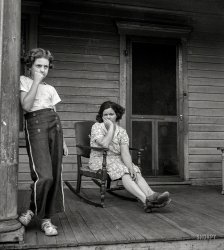
- The Experiment: 1941
- ... the Christiansted high school." Medium format negative by Jack Delano. View full size.
St. Croix Central High School St. Croix ... Posted by Dave - 02/11/2019 - 1:44pm -
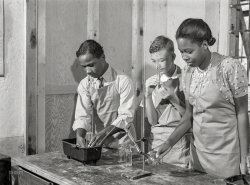
- Modern Family: 1941
- ... near Orwell, New York." Medium format negative by Jack Delano. View full size.
Where's the Mini-Bar? If they installed ... Posted by Dave - 01/31/2019 - 10:40am -
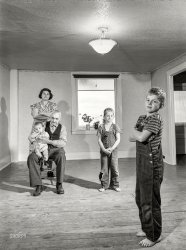
- Route 1: 1940
- ... No. 1. Baltimore, Maryland." Medium format negative by Jack Delano. View full size.
Ward Warehouse The nine-story ivory building ... Posted by Dave - 03/29/2019 - 7:09pm -
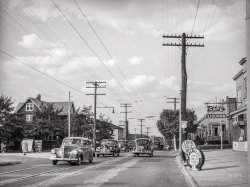
- Unread Messages: 1943
- ... a message is to be picked up by the train crew." Photo by Jack Delano for the Office of War Information. View full size.
Multitasking ... Posted by Dave - 08/07/2016 - 12:21pm -
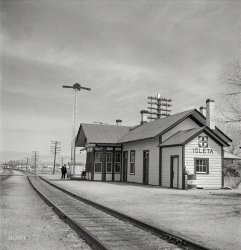
- Hyattsville: 1940
- ... Route 1 at Hyattsville, Maryland." Acetate negative by Jack Delano for the Farm Security Administration. View full size.
Old ... Posted by Dave - 03/26/2019 - 7:34pm -
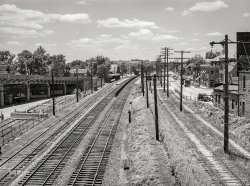
- Sky Chief: 1941
- ... Municipal airport, Washington, D.C." Acetate negative by Jack Delano. View full size.
Finally Lots of searching, results here. ... Posted by Dave - 02/14/2019 - 2:56pm -
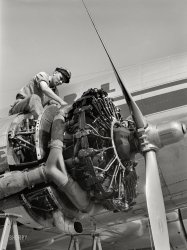
- Socks Partners: 1941
- ... mill, Greene County, Georgia." Medium format negative by Jack Delano. View full size.
(The Gallery, Factories, Jack Delano) ... Posted by Dave - 03/12/2019 - 9:27pm -
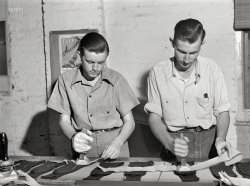
- Harbor Belt: 1943
- ... them for any special messages." Medium-format negative by Jack Delano, Office of War Information. View full size.
Wooden Dodo ... Posted by Dave - 01/23/2014 - 6:52pm -
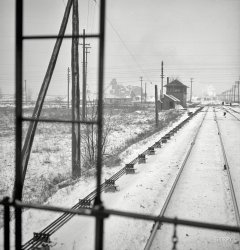
- Ice Baby: 1941
- ... Company in Midland, Pennsylvania." Acetate negative by Jack Delano. View full size.
Brrrrrrrrr Having grown up in Philadelphia, ... Posted by Dave - 12/27/2018 - 12:00pm -
![Ice Baby: 1941 January 1941. "Workers' houses near Pittsburgh Crucible Steel Company in Midland, Pennsylvania." Acetate negative by Jack Delano. View full size.
BrrrrrrrrrHaving grown up in Philadelphia, I can say the smart people are INSIDE!
Red is grey and yellow whiteBut we decide which is right
And which is an Illusion.
So, the traffic signal is on red or green?
The Non-Romantic Look of Cold and SnowGrey, cold, bleak. Delano is awfully good at bringing out that look. (And this is a great picture, right down to Mother and child at the window).
Wikipedia notes that, after the War, Delano settled in Puerto Rico. The antithesis of the cold, snow, bleak we see in these pictures. Hmm.
Stamped sheetmetal sled runners and uprightsCommon until well into the '60s, the runner sliding surfaces were just one edge of an L, often not well-made enough to be actually straight upright. And they were bendy. Not very good unless everything was frozen completely solid. The L flange needed to be much wider for snow. Kind of useless actually.
As kids we were so envious of the kids from next door. They had two sturdy sleds built by their father - the sliding surface runner was inch-wide metal strap firmly screwed to solid wood uprights - no bending. They made our store-bought sleds seem second rate and slid far further.
Re traffic lights: everywhere in the world, red is the top light!
[Incorrect. Back in the day, green was the top light on many a stoplight. - Dave]
Incorrect? Hardly, from my and any reasonable point-of-view.
Saw your other post after I sent mine, so I'll just ask you - back in what day, exactly? You need to provide some real evidence, like a street photo, of these rarely-occurring anomalies. tterrace's example is of a one-off design that never made it commercially. Hardly proof of widespread green light on top traffic signals even "back in the day".
After spending several hours last night looking for some evidence myself of your bald assertion, following my reading of an earlier Shorpy post which I actually read after the one I responded to, I was unable to find anything that sways me to it. Not a thing.
There is of course the Wikipedia entry about the Irish green light in Syracuse NY, and the debacle over that one light was in the 1920s! That had to be done as a special case because it did not meet the New York State Dept of Transportation guidelines in 1925. Maybe there's an anorak website with every combination of everything that ever happened in traffic light design somewhere - I couldn't find it. It would hardly matter if I had in the greater scheme of things.
So it seems no more than somewhat likely that green light on top might have been used by a mere few municipalities in the US, and probably before 1920. Nobody else worldwide bothered to get it wrong! Due to local financial concerns, sure, some anomalies may have not been replaced for years, confusing the color-blind and those folk who never can quite remember their left from right or east from west. Those who "remember" green on top are in that category, I'd suggest. Having conducted many safety hearings following accidents in my career, one thing I do know is that most people are quite unobservant, because their recounting of incidents never matches exactly, and some are fantasy.
There is all sorts of history as to why red is placed on top, both for longer visibility in fog due to color sensitivity and earlier detection by the motorist cresting a hill before an intersection, and so on. Not to mention catering to the 20% of males with red/green color-blindness by standardization of position.
A traffic light in Philadelphia in 1941, though? Get away with you. I'd bet money it was standard configuration.
An extremely minor use of green on top may have occurred, sometime, somewhere, a hundred years ago. I'll agree to that. But as a useful reaction to my and others' comments, to call universal use of red on top "incorrect" is pedantry. I know it when I read it, because I tend to be a pedant myself. Comes from being a professional engineer for 42 years and a manager of them for half that. So who cares about the .01% of lights that might have been upside down long ago? Not even me.
You own the site - you can claim right by might. However, if you insist on calling me incorrect, using the reason that very occasional anomalies once existed, remove my entire post forthwith, please. There are civil ways of mentioning occasional occurrences of something as points of interest. To make a bald impolite assertion of "incorrect" I cannot accept and won't be associated with in this case, thanks all the same.
[Green-on-top stoplights were (literal) fixtures of my childhood. On cross-country family trips in 1965 and 1971, I'd announce them to the rest of the car whenever I saw one, mostly in small towns of the American West. It took less than a minute of googling to find the ads below -- from the 1930 trade publication "Municipal Index," both showing green-on-top signals. Which I suspect comprised a substantial percentage of early 12-lamp fixtures. - Dave]
Click to enlarge.
On every cornerThe mom and baby are likely watching the kid on the sled, who's eyeballing the photographer right back. Fun family scene. Then there's that guy who's on every corner in these shots, the needs-a-drink guy. My seasonal best wishes go out to him this year.
In Defense of the Flexible FlyerThe sled which looks like to me as my old friend, Flexible Flyer, and panned as kind of useless actually by conundrum was not useless but loads of fun for my family.
Bought originally around 1940 for my older sister and used into the late 50's by my younger brother was a platform for daring do down the hills of Clifton Park.
Through the years there were many combinations of family and friends who rode the sled downhill towards Belair Road off a green adjacent to Clifton Park Terrace. The best snows were on weekends when Dad would be off and he would come along.
My father had taught my sister then my sister taught me and I in turn taught my brother.
When we were nearing the freezing point Dad took us to a store at Mareco and Belair that sold hot chocolate where he would order up us kids a round while he took Mom a few doors up to a local tavern for a shot of rye and a Gunther beer for himself and for Mom an Arrow draft beer.
Someday I'll have to get into the discussions my parents and my aunts and uncles on my father's side had about Gunther and Arrow beer when they came to our house for a Sunday afternoon visit.
Aunt Ana was neat since after drinking a beer she could blow up a balloon and it floated to the ceiling. Uncle Donald was cool too since he always had a few risque jokes to tell so he would give the kids a dime each to go buy some candy at the confectionary store up the street. At the time that bought a lot of candy since they were all penny candies and some were even 2 for a penny.
(The Gallery, Factories, Jack Delano, Kids)](https://www.shorpy.com/files/images/SHORPY-8c04464a.thumbnail.jpg)
- The Phantom Stroller: 1910
- ... booth.
The Third Level This makes me think of Jack Finney's " The Third Level. "
The corridor I was in began ... fleetingly visible. A monochrome, indoor version of Jack Delano's nocturnal light trails.
Why light? My question is what is ... Posted by Dave - 08/01/2012 - 5:43pm -
![The Phantom Stroller: 1910 New York circa 1910. "Suburban concourse, Grand Central Terminal, New York Central Railroad." Note the light trail left by a lantern-carrying phantom stroller in this time exposure. 8x10 glass negative, Detroit Publishing Co. View full size.
Only one lanternTo me it looks like he was only holding one lantern, and the light ribbons just happened to line up towards the spittoon (that he kicked closer to the column). Near the second column from the left, you can see the two ribbons diverge as he moved closer towards the information booth.
The Third LevelThis makes me think of Jack Finney's "The Third Level."
The corridor I was in began angling left and slanting downward and I thought that was wrong, but I kept on walking. All I could hear was the empty sound of my own footsteps and I didn't pass a soul. Then I heard that sort of hollow roar ahead that means open space and people talking. The tunnel turned sharp left; I went down a short flight of stairs and came out on the third level at Grand Central Station. For just a moment I thought I was back on the second level, but I saw the room was smaller, there were fewer ticket windows and train gates, and the information booth in the center was wood and old-looking. And the man in the booth wore a green eyeshade and long black sleeve protectors. The lights were dim and sort of flickering. Then I saw why; they were open-flame gaslights.
There were brass spittoons on the floor, and across the station a glint of light caught my eye.
This is great!I probably wouldn't have noticed that for a while if you hadn't pointed it out!
The Great Spittoon MysteryThis shot prompts two questions: What was the phantom stroller's direction of travel, and why his attention to the spittoons? My answers: toward the camera, and he was a spittoon attendant. First he stops at the drinking fountain to wet his whistle. The first ones he comes to may be one in two positions; the left one is much lighter, possibly indicating it was in that spot for a briefer period during the exposure. But there seems to be only one light trail, so that part's still a mystery. The next two he approaches from this side of the pillars; they'd be out of sight from his direction of travel. He determined that the nearer one didn't need emptying; the light trail indicates he approached it just enough to eyeball it. The farther one was either the same, or he managed to get it back close to its original spot. The last one, closest to the camera, he emptied, but replaced it in a different spot.
One in each hand?The light tracks aren't just parallel, the up-and-down jiggles match, too.
UnseenSure the phantom stroller is a great find, but I'm amazed because I don't think I've ever seen a picture of the old Suburban Concourse. It's much different today as restaurants have replaced the ticket windows, and that room in the back was completely replaced with a new staircase during the recent restoration.
I've always loved the Lower Level's straight lines, and it looks even better without all the clutter of today.
IlluminatingThe night porter is making his rounds here, ghostly legs fleetingly visible. A monochrome, indoor version of Jack Delano's nocturnal light trails.
Why light?My question is what is making the light streaks? Flashlight? Candle? Reflection? Why would he/she need a light when the place is already lit up?
[Janitors may have carried lanterns for the darker parts of Grand Central, where the tracks were all underground. - Dave]
1910!!Keep in mind that this remarkable scene dates from 100 years ago, when most homes in America had no electricity, indoor plumbing or telephones. The traffic at Park Avenue and 42nd Street would have been mostly horse-drawn. The world beyond the gleaming marble of Grand Central Terminal was largely constructed of wood and brick. There was no radio or TV. I'm not sure "computer" was even a word. If you wanted to go to Europe, you took a boat and spent the next week or so of your life heaving over the side rails. Once you crossed over into the wilds of Yonkers and Westchester County, there were more dirt roads than paved.
This building simply took people's breath away.
Baby is safeHarder to see in this photo are Kevin Costner and Andy Garcia (poised behind columns and ready to come out shooting). As we know now, the baby in the stroller was unharmed, although mom was terribly frightened.
LovelyAs a somewhat serious photographer, I can't help noticing that in 1910, they had wide angle lenses without barrel distortion. Today, after your lens renders the scene shaped like a pillow, you have to straighten it in Photoshop.
Baggage, telegraph and womenall kept out of sight.
The Great Exposure MysteryThis scene is chock full of light fixtures blazing, reflections and glare off the polished walls and floor, especially at the ticket counter closest to the camera. How could the exposure have lasted long enough for the "stroller" to have covered all that distance without the shot being a complete washout?
Just curious.
[The light fixtures etc. look as bright as they do because it's a long exposure. - Dave]
A thing of beautyHow sad that we seem to have lost our penchant for aesthetic beauty.
Junior'sJunior's restaurant is in this space now, in front of the ticket windows.
This is one case where I actually think it looks better now. In the photo, the place looks (obviously) empty and a bit scary.
(The Gallery, DPC, NYC, Railroads)](https://www.shorpy.com/files/images/4a24544a.thumbnail.jpg)
- In for Overhaul: 1942
- ... & North Western locomotive repair shops." Photo by Jack Delano, Office of War Information. View full size.
Overhaulin' ... was always a mystery to me.
(The Gallery, Chicago, Jack Delano, Railroads) ... Posted by Dave - 08/20/2014 - 10:17am -
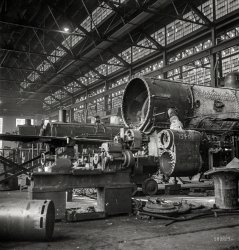
- Career Girls: 1941
- ... Bedford, Massachusetts." Medium format acetate negative by Jack Delano. View full size.
(The Gallery, Factories, Jack Delano, Kids) ... Posted by Dave - 11/29/2018 - 11:45am -
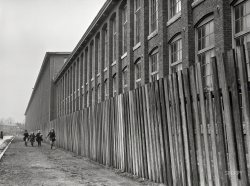
- Truck Talk: 1940
- ... Avenue. U.S. No. 1, Washington, D.C." Acetate negative by Jack Delano. View full size.
(The Gallery, Cars, Trucks, Buses, Eateries & ... Posted by Dave - 11/06/2018 - 8:08pm -
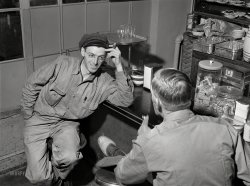
- Mission Control: 1943
- ... could use one of those desks at Shorpy Central. Photo by Jack Delano for the Office of War Information. View full size.
Thinking Time ... Posted by Dave - 05/01/2014 - 6:12am -
![Mission Control: 1943 March 1943. "Marceline, Missouri. A dispatcher at work in the Atchison, Topeka & Santa Fe Railroad offices." We could use one of those desks at Shorpy Central. Photo by Jack Delano for the Office of War Information. View full size.
Thinking TimeThe glass globe with the knob on the far right is a timer. When I visited an interlocking tower at a major junction, the operator explained that he had to set the timer before he could set a route. Then each change he made was locked down until the timer expired, which was after the next train was due. This made him think through his actions, and prevented last-minute corrections. I suppose it serves the same purpose here. I wonder if the three units to the left of it record the times that changes were made?
[Here, with a survivor, from Union Switch & Signal. -tterrace]
Time outFor about two years (97-99) I worked the lever operated interlocking at Springhill, Indiana on the Soo Line. We controlled movement of both Soo and CSXT traffic there, and the only time we engaged the timer was when an established ‘proceed’ route had to be changed. As I recall it took about eight minutes for a route to ‘time out,’ the longest eight minutes one could ever experience. Signals in advance of the interlocking gave the hogger on an approaching train a pretty good idea of what to expect at the interlocking, giving him the opportunity to set up his train handling for the plant. The timing device, for instance, prevented us from changing switches from a main line movement to a crossover move (requiring much slower speeds) when the train crew was rightly expecting to run straight through at maximum speed. Timers are still part of the most sophisticated CTC boards today, but they’re controlled by computer software. I suspect the three white faced devices controlled the train order boards outside the dispatchers office, which the timing apparatus was linked to.
Launch ControlI wonder what the three buttons under his elbow were for?
[Cream, Sugar, Lemon. - Dave]
(Technology, The Gallery, Jack Delano, Railroads)](https://www.shorpy.com/files/images/SHORPY_8d26440u.thumbnail.jpg)
- My Little Tommy: 1940
- ... Newtown, Connecticut." Medium format acetate negative by Jack Delano for the Farm Security Administration. View full size.
(The ... Posted by Dave - 12/18/2018 - 2:50pm -
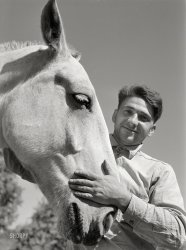
- Night Maneuvers: 1941
- ... the bus in Anniston, Alabama." Medium format negative by Jack Delano. View full size.
Transparent Soldiers? Why do the light ... Posted by Dave - 12/11/2018 - 10:33am -
![Night Maneuvers: 1941 May 1941. "Soldiers from a nearby Army camp waiting for the bus in Anniston, Alabama." Medium format negative by Jack Delano. View full size.
Transparent Soldiers?Why do the light streaks from passing vehicles pass behind the signs and mailbox but in front of the soldiers?
[Because they weren't standing there when the cars went by. - Dave]
Fort McClellanThe "nearby Army camp" would have been Camp McClellan (later Fort McClellan, which was closed in 1999).
Noble BusinessesThe soldiers are standing at the side of the Farmers Supply Company at 801-803 Noble Street. Some earlier sources give the address as 715 Noble. They sold a plethora of different goods including International trucks, farm and industrial tractors and equipment, buggies, wagons, feed, seed, harnesses, stoves, etc.
Also seen in the photo are the following businesses.
800-802 Noble: The Model Laundry
804-808 Noble: Farmers Supply Co. Used Cars
818-822 Noble: Callahan Grinding & Machine Co., Inc.
The picture below shows the front of the building, which burned down in the 1980s. All of the other structures are now gone as well.
"A Wandering Minstrel, I"Posters in the window feature an advert for the Rabbit's Foot Minstrels, a once famous traveling show that featured Black talent across the segregated South of the Jim Crow era, most famously through the Mississippi Delta region and beyond. During the 40's a Billboard ad tabbed the program as "the Greatest Colored Show on Earth"and seeking "Comedians, Singers, Dancers, Chorus Girls, Novelty Acts and Musicians." It was owned by various people until its ultimate demise as times and tastes changed in 1959. An historical roadside marker in Port Gibson, MS touts the impact of the Rabbit's Foot troupe on the development of blues music in American culture.
(The Gallery, Jack Delano, Small Towns)](https://www.shorpy.com/files/images/SHORPY-8c05782a.thumbnail.jpg)
- Drinking Buddies: 1941
- ... World's Fair in Tunbridge, Vermont." Acetate negative by Jack Delano for the Farm Security Administration. View full size.
(The ... Posted by Dave - 01/31/2019 - 11:28am -
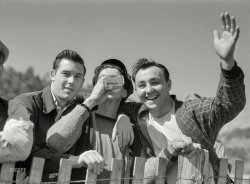
- Cannery Rows: 1941
- ... Miller, Negro FSA clients." Medium format negative by Jack Delano for the Farm Security Administration. View full size.
From a big ... Posted by Dave - 02/19/2019 - 1:40pm -
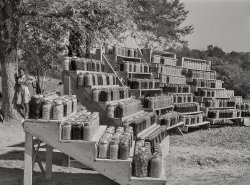
- Illinois Central: 1942
- ... Illinois Central Railroad yard." Medium-format negative by Jack Delano. View full size.
Parts This is apparently a switching ... Posted by Dave - 07/21/2014 - 12:40pm -
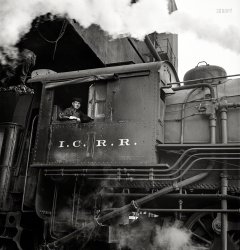
- Great Lakes Steel: 1942
- ... of War Information. - Dave]
Steel mill Just like Jack Delano was as well with RR picts. Thanks Dave. And a really big great thank you ... Posted by Dave - 08/10/2012 - 3:46pm -
![Great Lakes Steel: 1942 November 1942. "Hanna furnaces of the Great Lakes Steel Corp., Detroit. Coal pusher apparatus with coal storage building seen in the fog which constantly hangs over the plant." 4x5 Kodachrome transparency by Arthur Siegel. View full size.
Steel mill againAnother terrific pict, I love these of heavy industry which is almost gone today.How many photos did A Siegel take of steel mills? and he was lucky to be able to during WWII, I would think it would be off limits to take photos of steel mills during the war.
[He was working for the Office of War Information. - Dave]
Steel millJust like Jack Delano was as well with RR picts. Thanks Dave. And a really big great thank you for this wonderful photo blog, how did you get it started and when?
Steel MillThe machine in the picture is actually a coke pusher. The coke ovens are in its front and it pushed the coke out of the oven. I ran one of these as a young steelworker.
I knew a guy.....named Danny Reed, (speaking of coke pusher)......
Great guy,....I often wonder what happened to him.
Great Lakes SteelMy father was hired by GLS in 1958. Looking back, I think he loved this place. Anyone remember him?
Dale Forth Jr.
df7@dcx.com
Loved working thereI was hired here in 1971. Just came home from Vietnam and needed a job. The first few weeks hired as a track labor, 80 percent of the time our crew sat in shanties and ate tacos from our Mexican co-workers. I coundn't believe how easy the work was. After a year I was laid off and got hired at the Ford Rouge plant. Man I found out what work was. I worked at the Dearborn stamping plt and earned every penny. Anyway I ended staying there 31 years, retiring as a general foreman. I still think back at the mill. Good experience.
My DadMy dad used to work at the Michigan Steel plant as the storekeeper. Does anyone remember Harold Brown? I worked at Great Lakes too, in the boiler house.
-- Jim Brown
jimbrown2006@netscape.net
Also worked here.Fresh outta high school in '68, I worked at GLS for a few months, moving up from track labor to railroad signalman. (The steel was moved around by diesel engines.) I remember my first day on the job, a fella fell to his death. Good omen, eh?!
My GrampsMy grandfather Rocco G. worked there 43 years. Retired and then kept himself pretty dang busy for another 30 plus afterwards.
My dad, tooHe worked as a rigger from 1964-66 then from 1969-73 (break for Vietnam) before he got a job at Ford. Spent a lot of time on Zug Island. Bill Bryan, had the nickname "Badeye Junior". (no idea why) Mom could never get all the filth out of Dad's work clothes when he was working on Zug.
(The Gallery, Kodachromes, Arthur Siegel, Detroit Photos, Factories)](https://www.shorpy.com/files/images/1a35411u.thumbnail.jpg)
- Needle's Eye: 1943
- ... of the Atchison, Topeka & Santa Fe Railroad." Photo by Jack Delano. View full size.
Cooling towers The structures atop both ... Posted by Dave - 03/01/2014 - 10:14am -
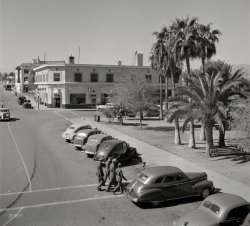
- Time to Make the Donuts
- ... least to see if there is something new. The photographs by Jack Delano that you put up made me buy 48 rolls of Kodachrome 64: great stuff while ... Posted by Dave - 08/05/2012 - 9:27am -
![Time to Make the Donuts June 1942. Truck driver at the Tennessee Valley Authority's Douglas Dam. View full size. Amazing 4x5 Kodachrome transparency by Alfred Palmer.
Amazing!
It looks like aAmazing!
It looks like a photo taken in a studio with a complex lighting setup. Or maybe a modern HDR photo. Hard to believe it was taken in the forties.
I love the color!I love the color of these Kodachrome transparencies you're posting. Absolutely marvelous! Please post more if you got 'em.
[Glad you like them. For many if not most of the ones we are posting, this is the first time they've been seen in all their high-res, color-corrected glory. - Dave]
Color correctionDave,
What color correction do you do to Kodachromes? Do 40s Kodachromes need any? I believe this particular emulsion should be good for something like 180 years when stored dry and dark.
BTW: Love this site and visit twice a day at least to see if there is something new. The photographs by Jack Delano that you put up made me buy 48 rolls of Kodachrome 64: great stuff while it lasts.
[Thanks. There was no color correcting for this one aside from hitting Auto Color in Photoshop, which will remove any color cast. Then there is usually a bit of tweaking with the Shadows and Highlights filter. One reason these look so nice is the large film size. The 4 by 5 inch Kodachrome sheets used to make these pictures have 18.4 square inches of usable surface area, which is 18 times as much as a 35mm film frame, which gives almost exactly one square inch. So there is a lot more information to work with. The archival tiffs for these images are from 130 to 200 mb in size. The Delano pictures tend to be underexposed and require a bit more tweaking. Below is a Delano shot with the before-and-after versions in alternating stripes. - Dave]
ExposureDave,
Thanks for taking the time for your comprehensive reply. Although I have a Graflex Crown Graphic 4x5, I am resigned to using it with Ektachrome 100 EPP readyloads, as Kodachrome is nowadays available in 35 mm only. The Kodachrome goes in a Leica M6 TTL therefor and has to be sent to Kansas (the only remaining K14 lab in the world) for processing.
The original Delano slide looks underexposed by at least a full stop and certainly benefits from your post processing. If Delano exposed like this consistedly, I wonder why.
Keep up the good work!
[The darkness of some of these may have to do with the settings used by the contractors who digitize these for the LOC. They may be erring on the side of caution. You can usually extract a nice picture from the tiff of an underexposed sheet whereas with an overexposed image you are pretty much stuck with what you see. - Dave]
Original Kodachrome FilmWe must remember that the original Kodachrome film was ASA 10 and very contrasty. It was hard to overexpose it! Kodachrome II (ASA 25) came out around 1960 and was far better.
These photographs are just so good! I can't tear myself away from the computer until I've seen them all. GREAT work, Dave.
Scanner?Can anybody comment on the scanner used for these shots?
[There is no scanner. The LOC transparencies are digitized using a Sinar studio back, which is something like a regular digital camera (but without a light source, which the user has to supply along with a lens, if one is needed). Basically a giant CCD array that records an image in one to four exposures. - Dave.]
(The Gallery, Kodachromes, Alfred Palmer, WW2)](https://www.shorpy.com/files/images/1a35238u.thumbnail.jpg)
- Chicago Fog: 1942
- ... An unusually heavy fog in the early afternoon." Photo by Jack Delano for the Office of War Information. View full size.
After That ... Posted by Dave - 02/13/2017 - 1:03pm -
![Chicago Fog: 1942 December 1942. "Chicago, Illinois. An unusually heavy fog in the early afternoon." Photo by Jack Delano for the Office of War Information. View full size.
After That Bus, Watson!Save for the street furniture and bus markings, this could be London on a clear day back when everyone heated with coal. The buses' position on the street gives nothing away because they appear to be driving roughly in the middle -- a tendency toward which has not infrequently been ascribed to bus drivers on both sides of the water.
Royalty in the MistThe double-decker bus looming out of the fog is a Yellow Coach Model 720, which was nicknamed Queen Mary in a nod to the famous Cunard superliner RMS Queen Mary, launched in 1936.
The Chicago Motor Coach Company had 100 of the Series 2 that were built in 1936, and 40 of the Series 4 (fuel tank and battery location moved to eliminate fire hazards) that were built in 1938. They proved to be very useful and many of them were rebuilt several times before finally being retired in the early 1950s. The Fifth Avenue Coach Company bought 25 Series 3 and 35 Series 5, which were the New York versions of the Series 2 and Series 4 respectively, with some body changes.
According to New York Fifth Avenue Coach Company: 1885-1960 by Oliver J. Ogden, bus Number 104 (seen in the bright sunlight below) was:
the Yellow Coach demonstrator for the new Queen Mary Design. After it was shown in New York, it kept the No. 104 but was relettered "Chicago Motor Coach." It stayed with Chicago and then was sold to Coast City Coaches of New Jersey in 1945. [Via Motor Bus Society]
Actually, it was destined for Chicago all along as it was intended to replace No. 103—the 1933 Model 706 prototype that was the basis for the Model 720 (and which, after retirement, appeared in several movies). The New York Model 720s were numbered in the 2000s. No. 104 was actually the only Series 1, built in 1934 and used in 1935 as a demonstrator on Route 5 in New York City before being sent to Chicago to be put into regular service.
Why all the swapping around? Because both the Chicago Motor Coach Company and the Fifth Avenue Coach Company were both owned by the Omnibus Corporation and shared the same paint scheme. And the Omnibus Corporation and the Yellow Truck and Coach Manufacturing Company were the brianchilds of John D. Hertz, along with Hertz automobiles, Hertz Rent-a-Car, Yellow Cab Company, etc., etc.
The Model 720 were visually similar to the Yellow Coach Model 735s, but Chicago Motor Coach Company did not acquire any Model 735s. A 1936 Series 2 is seen below.
They were so popular that kids got to get in on the action.
(The Gallery, Cars, Trucks, Buses, Chicago, Jack Delano)](https://www.shorpy.com/files/images/SHORPY-8d23808a2.thumbnail.jpg)
- Long Train Going: 1943
- ... Clovis, New Mexico." One of hundreds of photos documenting Jack Delano's trip from Chicago to California on a Santa Fe freight for the Office ... Posted by Dave - 03/20/2013 - 1:46pm -
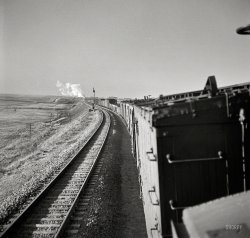
- War Store: 1941
- ... making plans to move." Medium format acetate negative by Jack Delano. View full size.
Fly Ribbon You've gotten your money's worth ... Posted by Dave - 01/17/2019 - 10:51am -
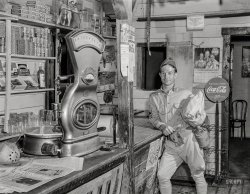
- Jewish Farmers Exhibit: 1909
- ... a dream come true. This photo, taken among many others by Jack Delano, is my great-grandfather, Abraham Metzendorf.
Beehives Those ... Posted by Dave - 08/07/2012 - 12:13pm -
![Jewish Farmers Exhibit: 1909 New York. October 13, 1909. The Federation of Jewish Farmers of America exhibit at the Educational Alliance building, East Broadway and Jefferson Street. 8x10 glass negative, George Grantham Bain Collection. View full size.
The EdgiesI had more than a few friends that grew up on the Lower East Side. The one thing they had in common was the Educational Alliance, or the "Edgies" as they referred it to it. They were able to get advice and help during tough times. It is still there helping the locals, mainly Hispanic and Asian. Seward Park High School had students speaking more than 50 languages and dialects; 80 percent of the pupils came from homes where English was a second language. The school has recently been broken up into five smaller schools to better cater to the students' diverse population. The list of successful graduates and beneficiaries of the Edgies is enormous.
Back to the GardenWoodstock took place on the fields of a Jewish farmer. Max Yasgur was his name.
Farm teamYes, Jewish athletes were common among 1900-1920's boxers and ballplayers. That is and was a common American career path for the youths of virtually all incoming immigrant groups.
That is getting on about about 100 years ago. There does not seem to be too many Jewish NBA stars these days, judging from the complete lack of them.
There is likewise a dearth of American kibbutzes. As for Jewish farms in the U.S., I was going to say that law and medical schools are fertile grounds for growing young Jewish doctors and lawyers, but I absolutely decided not to go there.
Six-pointersActually, Israel has a thriving agricultural sector, and basketball was largely a Jewish sport in the 1920s and 1930s.
Okay then....its two, two, two girls in one (although I have been known to see double at times).
Baruch AtahYou'd think those four young boys never saw giant Yiddish Yams before.
Mazel Tov to the growers.
Jewish Farmers of America?Jewish Farmers of America? New one on me. I imagine that organization meets about as often as the Association of Jewish NBA Centers.
We all knew Old McDonald had a farm. I didn't know about Old Moishe.
Still, someone has to grow our Kosher okra.
I'm no bigot, but"Jewish Farmer" strikes me as an oxymoron.
[Ever hear of a kibbutz? - Dave]
The Farmer's DaughtersThe two pretty young ladies on the extreme right are reminiscent of Tevya's daughters in "Fiddler on the Roof." The young men selling their produce are providing the girls amusement by apparently humoring the fascinated young boys about the pumpkins and other squash. Sunrise, sunset, it looks like a good time is being had by all in this very happy picture. Thank you.
[This is a double exposure. That's one pretty young lady on the right. - Dave]
Jewish farmersI would refer any skeptics to the Jewish Agricultural and Industrial Aid Society, founded in 1900 by Baron de Hirsh, and whose function was to relocate immigrant Jewish farmers across the United States and fund them with low-interest loans through the first credit unions to be established in this country. My grandfather Leonard G. Robinson, an immigrant himself from Russia, was one of the authors of the Federal Farm Loan Act, and eventually became president of the JAIAS.
Leonard G. RobinsonThat's amazing. I would love to learn more about your grandfather and his involvement with both the federal farm loan act and the JAIAS.
Jewish farmers in ConnecticutI'd just like to add to the comments here that for Jewish immigrants from the Pale of Settlement, having a plot of land was a dream come true. This photo, taken among many others by Jack Delano, is my great-grandfather, Abraham Metzendorf.
BeehivesThose boxes to the left of the smiling man in white. (I wish I knew what H.A.S. means, although I suspect the A is for Apicultural.) The white-on-black sign in Yiddish above the hives reads Clean Bees.
(The Gallery, G.G. Bain, NYC, Stores & Markets)](https://www.shorpy.com/files/images/01657u.thumbnail.jpg)
- Li'l Skeptics: 1943
- ... absorbed into the Office of War Information. Probably only Jack Delano and Gordon Parks (both well represented on Shorpy) caught the look of ... Posted by Dave - 09/13/2011 - 1:55pm -
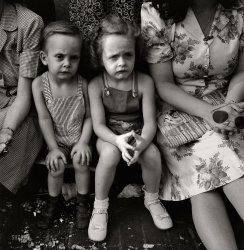
- Pittsburgh Posts: 1941
- ... film plane of my 1937 Ikoflex (identical to one used by Jack Delano) and sighted across the facade of my row of townhouses. At f/8 the depth ... Posted by Dave - 06/06/2020 - 12:53pm -
![Pittsburgh Posts: 1941 June 1941. "Rain. Pittsburgh, Pennsylvania." Medium format acetate negative by John Vachon for the Farm Security Administration. View full size.
Is the circus in town?What is that large tent filling the street a block ahead?
Ah, I see nowIt's an awning on the next porch.
A thousand words?This is a picture you can hear.
DepthConsidering the light level, Vachon has achieved great depth of field without resorting to a slow shutter speed (man and umbrella in motion not blurred). I view in awe. Camera? Rollieflex?
Great Cars!Facing us across the street is a 1935 Chevrolet. The third car, facing us, is a 1940 Chevrolet. The first car facing us on the right is a 1936 Ford.
Bonus lovelinessThe abacus motif of the transom grill directly above the porch rail is just plain beautiful.
Posts and balusters still there!Astute Shorpy followers will notice that the fragment of column on the far left is the same column as the one seen in a different view posted in June 2008:
https://www.shorpy.com/node/3793
The location was identified in a comment as being on the corner of Madison and Lockhart. Here's the same view from the same location today:
https://goo.gl/maps/J1xaf8nmE5AJNUQ87
Posts and balusters are still present at this location. The lack of spindlework causes it to lose some of its old charm, in my opinion.
Ticket TimeParking left wheels to curb brings a parking ticket nearly everywhere. Well, except in England, of course.
Depth of FieldI had the same reaction that ManyBuicks did. I shoot with several twin lens reflex cameras from the 1930s, so I experimented a bit. I fastened a piece of frosted mylar at the film plane of my 1937 Ikoflex (identical to one used by Jack Delano) and sighted across the facade of my row of townhouses. At f/8 the depth of field was barely adequate, and not nearly as good as in Vachon’s rain shot. Considering that the original photo was probably shot at about 1/50 second (common on cameras of that era) to almost stop the walker, and the day was quite dark, I think that would have required film with an unrealistically high ASA speed, especially for those years.
Then I found the original scan at the Library of Congress. The film was medium format, alright, but it was sheet film. (The notch codes are visible.) That means that Vachon could have used a 2x3 Speed Graphic camera. They don’t have a front swing movement for the lens, but by dropping the bed and holding the camera sidewise, you can achieve the same result.
However he did it, John Vachon knew what he was doing.
[The film size is 4¼ x 3¼ inches. --Dave]
Singing In The RainJust, singing in the rain. What a glorious feeling.
Thanks to the keen eye of davidk I am also mesmerized by the abacus motif.
A distinction without a differenceSagebrushCity might have missed the format size of the camera, but everything else he posited Vachon doing could have been done just as well with a 4¼ x 3¼ Graphic, which also existed at the time (I used to have one).
(The Gallery, Cars, Trucks, Buses, John Vachon, Pittsburgh)](https://www.shorpy.com/files/images/SHORPY-8c19404a.thumbnail.jpg)
- Standard Service: 1940
- ... started to collect them last year. I found this image of Jack Delano somewhere in cyberspace. I believe that's a Zeiss Ikon Ikoflex around ... Posted by Dave - 11/14/2019 - 11:35am -
![Standard Service: 1940 April 1940. "Gas station on a sunny afternoon. Dubuque, Iowa." Medium format acetate negative by John Vachon for the Resettlement Administration. View full size.
Hairy CatConsidering the Cat's hair in this self-portrait (https://www.shorpy.com/node/25187), I wonder if Mr. Vachon was peering over the camera and looking at the lens (or out the window) the moment this exposure happened.
[He was looking down into the viewfinder. - Dave]
That does double for me!I loved all my twin-lens reflex cameras and wish I had kept them. But nnnnoooooo ...
Current view?The Page Hotel, located in the upper left, was located at the corner of Fourth and White streets. This view from Google Maps, appears to show approximately the same view. Not sure if the existing brick building across the tracks is the same one in the current view.
U.S. 61 Freeway There NowBased on this article, the Page Hotel stood at Fourth and White Streets, about where the U.S. 61 freeway is now.
http://www.encyclopediadubuque.org/index.php?title=PAGE,_John
Heavy metalBeing a steam locomotive fanatic, I would want a room facing the tracks in the hotel. Unfortunately I wouldn't be born until Nov. of 1940. Looks like a busy crossing and with the baggage carts must be right at the depot.
John VachonJohn Vachon's FSA pictures are sadly underrated. He was highly influenced by Walker Evans, whose plain and unpretentious portraits showed little evidence of advocacy or drama. Vachon had the same style, but his subject matter often differed from that of Evans. Vachon was young and inexperienced when he was hired by FSA head Roy Stryker. He fell in love with the camera, and loved touring the country for the first time. He photographed just about everything he saw, in this case a gas station near the railroad tracks. Consequently, his vast collection of pictures has become a valuable document of how life and the built environment looked in the 1930s.
If you build it they will comeIt's kind of hard to see but if you follow the road (4th Street) from the bottom towards the top of the picture you will see a baseball stadium in the distance. It was known alternatively as Municipal Stadium, 4th Street Stadium, or John Petrakis Park. It was built in 1915 and was razed sometime in the 1970s, I believe. It hosted several minor league ballclubs.
Double visionUnlike commenter Jim Page, I'm a newcomer to twin-lens reflex cameras, having started to collect them last year. I found this image of Jack Delano somewhere in cyberspace. I believe that's a Zeiss Ikon Ikoflex around his neck. Being a serious fan, I just had had to buy one.
Gas PricesWhat's up with the sign? Prices? Octanes?
[Yes. - Dave]
Photographer's viewpointWell, we can see where the photo was taken from in radiochris's modern shot.
There was a fire here, tooThe six-story brick building shown in the "Current View" post is the Canfield Hotel, built in 1927 as an addition to the existing four-story wooden structure. In 1946 a fire destroyed the older wooden building, killing 19 people, including owner William Canfield. The picture would have been taken from the four-story wooden part. An account of the fire:
http://www.encyclopediadubuque.org/index.php?title=CANFIELD_HOTEL
(The Gallery, Cars, Trucks, Buses, Gas Stations, John Vachon, Railroads)](https://www.shorpy.com/files/images/SHORPY-8c16972a.thumbnail.jpg)























